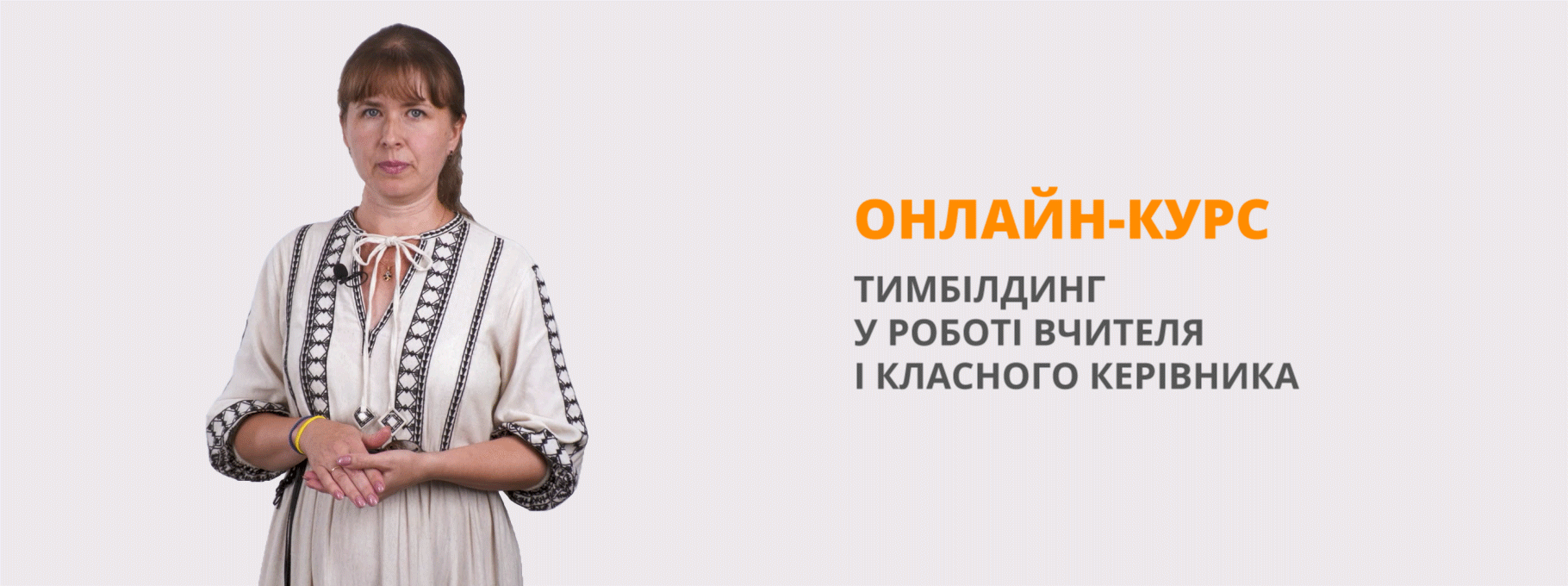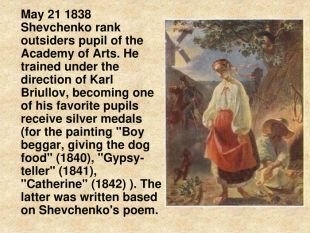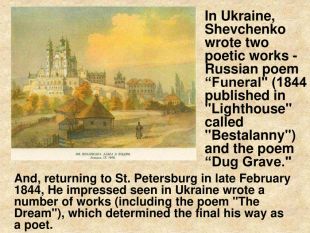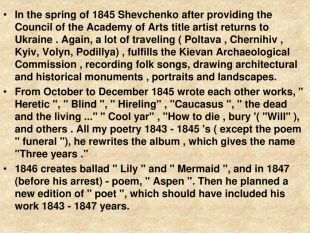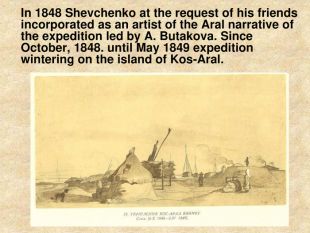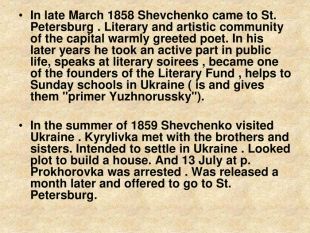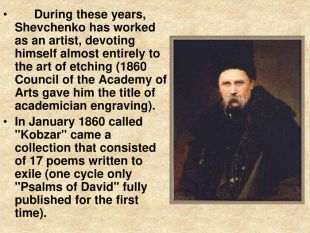Презентація: "Taras Shevchenko"
Про матеріал
Short Biography
Childhood
St. Petersburg Period
Arrest and Exile
Final Years
Quick facts on Shevchenko Biography
My Destiny - an autobiographical essay by Taras Shevchenko
Short Biography
Taras Hryhorovich Shevchenko, the great Ukrainian poet, artist and thinker, was born on March 9, 1814, in the village of Moryntsi in central Ukraine, then part of the Russian Empire. His parents, H. Shevchenko and K. Shevchenko, were serfs on the land of V. Engelhardt.
T.Shevchenko
Self-portrait with candle, 1861
His grandfather I. Shevchenko, who was a witness of the Haidamak movement, had a significant influence on Taras. Taras's father was literate, and he sent his son to be educated as an apprentice to a deacon. In 1823, Taras's mother died, and his father married for a second time. In 1825, his father also died. For some time little Taras, now an orphan, served as a houseboy and was in training as a servant. A talent for drawing showed itself in the boy quite early. When he was 14 years old, he became a domestic servant to P. Engelhardt.
In the spring of 1829, Taras travelled with P. Engelhardt to Vilnius, Lithuania. There he studied painting under an experienced craftsman. The Polish rebellion for national liberation from Russia began in November, 1830, and Engelhardt left for the Russian capital, St. Petersburg. Shevchenko stayed with the lord's servants in Vilnius and was witness to the revolutionary events. Shevchenko went to St. Petersburg at the beginning of 1831. In 1832, the lord "contracted" him to the master painter V. Shyryayev, with whom the lad experienced a hard school of professional training.
Self-portrait, 1845 Noted writers and artists bought Shevchenko out of serfdom. The 2,500 rubles required were raised through a lottery in which the prize was a portrait of the poet, Zhukovsky, painted by Karl Bryullov. The release from serfdom was signed on April 22, 1838. A committee of the Association for the Encouragement of Artists had examined drawings by Shevchenko and approved them. In 1838, Shevchenko was accepted into the Academy of Arts as an external student, practicing in the workshop of K. Bryullov.
In January, 1839, Shevchenko was accepted as a resident student at the Association for the Encouragement of Artists, and at the annual examinations at the Academy of Arts, Shevchenko was given the Silver Medal for a landscape. In 1840 he was again given the Silver Medal, this time for his first oil painting, The Beggar Boy Giving Bread to a Dog.
In the library of Yevhen Hrebinka, he became familiar with anthologies of Ukrainian folklore and the works of I. Kotlyarevsky, H. Kvitka-Osnovyanenko, and the romantic poets, as well as many Russian, East European and world writers.
Shevchenko began to write poetry even before he was freed from serfdom. In 1840, the world first saw the Kobzar, Shevchenko's first collection of poetry. Later Ivan Franko wrote that this book, "immediately revealed, as it were, a new world of poetry. It burst forth like a spring of clear, cold water, and sparkled with a clarity, breadth and elegance of artistic expression not previously known in Ukrainian writing." In 1841, the epic poem Haidamaky appeared as a separate volume. In September of that same year, Shevchenko got his third Silver Medal -- for his picture The Gypsy Fortune Teller. A significant work is the painting Kateryna, based on his poem.
Shevchenko also tried his hand at writing plays. In 1842, a fragment of the tragedy Nykyta Hayday appeared, and in 1843 he completed the drama Nazar Stodolya.
In this period, the full genius of Shevchenko was apparent, and the main characteristic of his poetry - a deep national sense - was evident. All his life, the poet was devoted to his nation. "Body and soul I am the son and brother of our unfortunate nation," he wrote.
Opposition to the social and national oppression of the Ukrainian people grew in Shevchenko. Tsarist Russian censorship deleted many lines from his works, and created problems for the printing of the writer's poetry. None of the critics of the Kobzar, however, was able to deny the great talent of Shevchenko.
In 1843, the poet left St. Petersburg, and at the end of May he was in Ukraine. In Kiev, he met M. Maksymovich, P. Kulish and others, and did many paintings.
That summer, the poet visited the sites of the former Zaporozhian Cossack Sich, and in September he went to Kyrylivka where, after a fourteen-year separation, he saw his brothers and sisters. In Ukraine Shevchenko did many pencil studies for a projected book of engravings to be called Picturesque Ukraine. At the end of February Shevchenko returned to St. Petersburg.
In Ukraine, the poet had seen the heavy social and national yoke borne by the working people and the inhuman conditions of life of the peasants. This evoked new themes in Shevchenko's poetry.
It was useless to think of publishing political poetry in conditions of Russian tsarist censorship. The works of the Polish poet Adam Mickiewicz had a great influence on Shevchenko, especially in the writing of political satire. One of the highlights of the political poetry of Shevchenko is the satirical poem Son (The Dream).
In Lihvin, 1859 On March 22, 1845, the Council of the Academy of Arts decided to grant Shevchenko the title of artist. On that same day, he approached the leadership of the Academy with a request for a "pass" for a trip to Ukraine.
In Kiev, the poet met again with M. Maksymovich, and was commissioned to paint historical sites. Shevchenko visited Kyrylivka, and in the fall of 1845, on an appointment by the Archeological Commission, he left to paint the historical and archeological sites of Poltava. In Myrhorod, the poet wrote the mystery play The Great Vault. Toward the end of October, Shevchenko went to Pereyaslav, where he lived until early 1846.
In the spring of 1846, the poet lived for some time in Kiev, where he met the members of the Kyrylo-Methodius Society. The views of the poet had a great influence on the program of this secret society and on the philosophical outlook of many of his contemporaries.
In 1847, arrests began of the members of the Kyrylo-Methodius Society and Shevchenko was arrested on April 5, on a ferry crossing the Dnipro River near Kiev. The next day, the poet was sent to St. Petersburg. He arrived there on April 17, 1847, and was imprisoned. Here he wrote the cycle of poems In the Dungeon. Of all the members of the association who came under investigation, Shevchenko was punished most severely: he was exiled as a private with the Military Detachment at Orenburg. Russian Tsar Nicholas I, in confirming the sentence, wrote, "Under the strictest surveillance, with a ban on writing and painting."
On June 8, 1847, Shevchenko was established at distant Orenburg, and later he was sent to the fort at even more distant Orsk. From the very first days, Shevchenko violated the tsar's order. He transcribed the prison cycle into a small secret book he kept in his boot, and he wrote new poems into the book. In 1848, Shevchenko was included as an artist in the Aral Sea Survey Expedition. In 1850, Shevchenko was arrested for violating the tsar's order. Warned by his friends, the poet was able to give them his notebooks and to destroy some letters. The poet was taken to Orsk, where he was questioned. Then he was sent to a remote fort in Novopetrovsk. Once again, strict discipline was imposed, and the poet was subjected to more rigorous surveillance. It was not until 1857 that Shevchenko finally returned from exile, thanks to the efforts of friends.
While awaiting permission to return, Shevchenko began a diary, an important documentation of his views. On August 2, 1857, having received permission to travel to St. Petersburg, Shevchenko left the fort at Novopetrovsk. In Nizhniy Novgorod, he learned that he was forbidden to go to Moscow or St. Petersburg, on pain of being returned to Orenburg.
Self-portrait, 1851 A kind doctor attested to Shevchenko's illness, and the poet spent the entire winter in Nizhniy Novgorod. The winter of 1857-58 was very productive for Shevchenko. During that time he painted many portraits and other paintings. He also edited and transcribed into the Bilsha Knyzhka (The Larger Book) his poems from the period of exile, and wrote new poetic works. After receiving permission to live in the capital, he went to St. Petersburg. After his exile, Shevchenko devoted his greatest attention as an artist to engraving, and in this field he became a true innovator.
In May, 1859, Shevchenko got permission to go to Ukraine. He intended to buy a plot of land not far from the village of Pekariv, to build a house there, and to settle in Ukraine. In July he was arrested on a charge of blasphemy, but was released and ordered to go to St. Petersburg without fail. The poet arrived there on September 7, 1859. Nevertheless, to the end of his life, the poet hoped to settle in Ukraine.
In spite of physical weakness as a result of his exile, Shevchenko's poetical strength was inexhaustible, and the last period of his work is the highest stage of his development. In a series of works, the poet embodied the dream of the people for a free and happy life. Shevchenko understood that the peasants would gain their freedom neither through the kindness of the tsar nor through reforms, but through struggle. He created a gallery of images - Champions of Sacred Freedom - of fighters against oppression and tyrarnny. On September 2, 1860, the Council of the Academy of Arts granted Shevchenko the title, Academician of Engraving.
The poet began to feel increasingly ill, and complained in letters about the state of his health. Taras Shevchenko died in his studio apartment St. Petersburg at 5:30 a.m. on March 10, 1861. At the Academy of Arts, over the coffin of Shevchenko, speeches were delivered in Ukrainian, Russian and Polish. The poet was first buried at the Smolensk Cemetery in St. Petersburg. Then Shevchenko's friends immediately undertook to fulfil the poet's Zapovit (Testament), and bury him in Ukraine. The coffin with the body of Shevchenko was taken by train to Moscow, and then by horse-drawn wagon to Ukraine. Shevchenko's remains entered Kiev on the evening of May 6, and the next day they were transferred to the steamship Kremenchuh. On May 8 the steamship reached Kaniv, and Taras was buried on Chernecha Hill (now Taras Hill) by the Dnipro River. A tall mound was erected over his grave, and it has become a sacred site for the Ukrainian people.
Перегляд файлу
Зміст слайдів
ppt
До підручника
Англійська мова (8-й рік навчання) 8 клас (Карпюк О.Д.)
Оцінка розробки


Безкоштовний сертифікат
про публікацію авторської розробки
про публікацію авторської розробки
Щоб отримати, додайте розробку
Додати розробку
